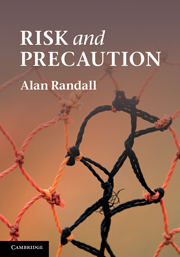Book contents
- Frontmatter
- Contents
- List of figures
- List of boxes
- Authors cited
- Acknowledgements
- List of acronyms
- Part I The precautionary principle – why so much fuss about such a simple idea?
- 1 Precaution as common sense: “Look before you leap”
- 2 Commonsense precaution or paralysis of fear?
- Part II Harm and chance – managing risk
- Part III Defining and justifying a coherent precautionary principle
- Part IV Precaution in action
- Part V Conclusion
- References
- Index
1 - Precaution as common sense: “Look before you leap”
Published online by Cambridge University Press: 05 June 2012
- Frontmatter
- Contents
- List of figures
- List of boxes
- Authors cited
- Acknowledgements
- List of acronyms
- Part I The precautionary principle – why so much fuss about such a simple idea?
- 1 Precaution as common sense: “Look before you leap”
- 2 Commonsense precaution or paralysis of fear?
- Part II Harm and chance – managing risk
- Part III Defining and justifying a coherent precautionary principle
- Part IV Precaution in action
- Part V Conclusion
- References
- Index
Summary
What do thalidomide, asbestos, PCBs (polychlorinated biphenols), nuclear waste, depletion of international fisheries, and climate change have in common? They are serious public health and/or environmental problems with some common elements in their histories. In every case, activities undertaken for good reasons – to serve demands that were genuine, to reduce costs or keep them low, and in the process to raise standards of living – led eventually to enormous damage and expense, or the prospect thereof. What went wrong? After all, our societies were not born yesterday. They are aware of the risks posed by innovation, resource exploitation, and overstressing our environmental systems, and they maintain institutions to assess risks and regulate potentially harmful activities. Yet, these institutions failed quite clearly to prevent or minimize the potential harm.
In each of these cases, the standard approaches to risk management failed in several or all of the following ways: they did little to prevent the threat; were slow to diagnose it; tolerated far too much dispute about harm and cause before taking action; and acted only after the problem was obvious, widespread and built into the economy, society, and way of life, so that remedies were enormously expensive and relatively ineffective. Because remedies were implemented too late to forestall the damage or restore the status quo ante, they necessarily were focused more on remediation, mitigation, and adaptation.
- Type
- Chapter
- Information
- Risk and Precaution , pp. 3 - 16Publisher: Cambridge University PressPrint publication year: 2011



